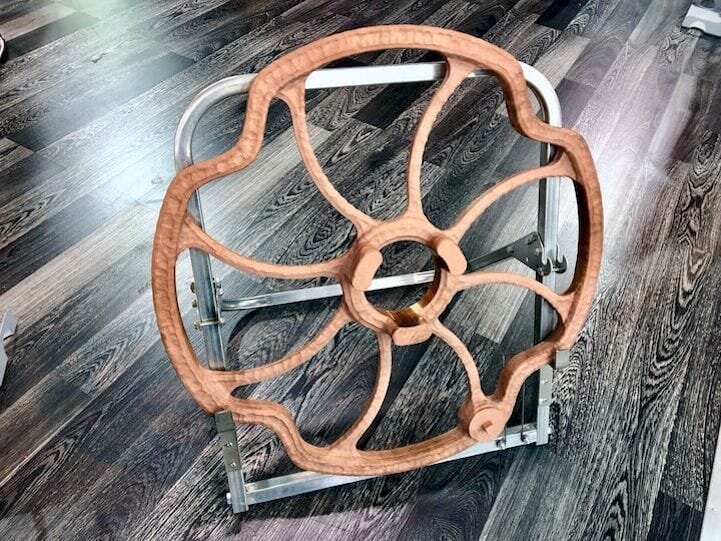![Copper part made by Spee3D [Source: Fabbaloo]](https://fabbaloo.com/wp-content/uploads/2020/05/spee3d-copper-large-1_result_img_5eb050b23cd20.jpg)
I’ve recently had chats with folks from a few companies offering what’s called “cold spray” technology.
In this process a metal powder is blasted out of a nozzle by means of high pressure gas. The metal particles impact a target where they bond with previously expelled particles to gradually build up a full object.
This is not a new process. It’s been around since at least 1990, and it has an unusual birth. Wikipedia explains:
“Cold spraying was developed in the 1990. While experimenting with the particle erosion of the target, which was exposed to a two-phase high-velocity flow of fine powder in a wind tunnel, scientists observed accidental rapid formation of coatings. This coating technique was commercialized in the 1990s.”
It’s been long used as a technique for applying coats to previously made objects. However, more recently this approach has been used to create some powerful 3D printing options.
While the “coating” approach simply applies a (hopefully) uniform layer on a surface, machines performing additive manufacturing with the cold spray process have recently been devised by several players.
One of the most notable is Spee3D, the Australian company whose process blasts the metal particles at the target so rapidly they are literally supersonic. The impact briefly removes the omnipresent oxygen layer between materials, allowing bonding to occur.
There are some interesting advantages to the cold spray technique, and perhaps the most notable is that it can be used with a wide array of metals. Copper is notoriously difficult or impossible to 3D print on conventional powder bed / fusion 3D printers, but is relatively easily accomplished with cold spray methods.
Another advantage to cold spray processes is that it’s possible to change the material in mid print. This is done by simply pausing the print and swapping out the powder hopper — presumably with a bit of purge, first.
Another advantage is that the quality of the powder doesn’t have to be quite as amazing as those used on powder bed / fusion systems. This lowers the effective cost of the input materials for cold spray techniques, which is quite welcome for many applications.
One issue with cold spray techniques it that it doesn’t really produce highly detailed prints. The blasting process introduces a lot of scatter and while vendors try to manage that, the parts can be pretty coarse.
This is where it gets interesting. Several cold-spray vendors have realized this effect might limit their sales, so several have introduced hybrid machines that are part 3D printer, and part CNC mill.
The idea is to use the CNC mill to produce ultra-smooth surfaces, as it does with conventional milling operations. However, in this case it’s milling a freshly 3D printed metal object — with a coarse surface.
I know what you’re thinking. You suspect that a 5-Axis CNC mill could not reach into all the nooks and crannies of a complex 3D print, so how on Earth could you produce a smooth surface?
You’d be quite right, but there is some trickery here. What several vendors do is after each metal deposition layer, or in some cases several layers, the 3D printing is paused and the CNC milling tool head swings into play.
The mill CAN reach most of the surfaces if you apply it layer by layer. Of course, there are many pathological geometries that this won’t work, but the approach dramatically increases the geometries that do work.
The result is 3D printed metal parts that appear to have near perfect, CNC-quality surfaces. That’s because they ARE CNC milled surfaces!
The presence of the CNC tooling obviously adds to the cost of the machines, but it enables a far wider set of applications for clients.
In particular this approach could allow clients to request low volumes or even single units of a metal part at relatively low cost, far lower than the typical manufacturing costs. That’s because the amount of material used is far lower, and that cost can overwhelm the cost of the added equipment.
Will we see cold spray techniques taking over? I’m not sure they will, as the powder bed / fusion systems are very useful for the applications they are deployed for, such as aerospace and healthcare. But for lower-end applications as one might find at a local foundry, cold spray might be the correct approach.


You typeset these web-pages in a very light gray font, which make them difficult to read (for me, 71 years old).
What I was typing myself is okay in this comment field!
You typeset these web-pages in a very light gray font, which make them difficult to read (for me, 71 years old).
What I was typing myself is okay in this comment field!